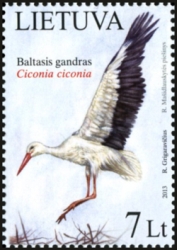
Stork spotting
I first spied a stork in Lithuania from the back of a bike. It was the dead of summer, a blazing hot July day cycling in the grassy countryside northwest of Vilnius. We were cycling up to Kernave for Midsummer’s Day celebrations, expecting bonfires, singing, sausages, and candles floating in the river. It was the type of hot, sunny day that drew out smatterings of wildlife here and there – a few cats, cranes, even a fox once. We kept to the forests where we could, crossing dirt paths and sandy roads. But sometimes the sand was too much, and drove us out onto a paved backroad with no trees in sight. A couple hours into the ride, we spied a telephone pole topped with a thicket. A nest. Catching a glimpse of a thin bird overhead, I pointed at the sky: “Gandras!” We watched it as it glided downward, silent, soon swallowed up by grassland.
The Ballads of Kukutis
“My, Vilnius is big!
At one end
A stork stands –
At the other
It claps its beak.”
So begins the Lithuanian poem “Kukutis’ Visit to Vilnius” by Marcelijus Martinaitis, in his bucolic Ballads of Kukutis. The longer I live in Lithuania, the more I see nature in everything. The emblem of Vilnius is an iron wolf. Other cities celebrate the auroch, moose and bear. As one local proverb goes: “If you run from a wolf, you may run into a bear.”
Since 1973, Lithuania has claimed the white stork as its national bird, a symbol of family, domestic life, birth and prosperity. As in many European cultures, the stork traditionally is said to bring babies into the household. The phrase “Gandras atnešė broliuką!” uttered by a midwife: “The stork brought a brother!” Even today, they’re said to bring harmony to families on whose property they nest. As we saw on that bicycle trip, many village homes still have old wagon wheels or poles in the hopes that a stork family will make it their nest.

The first stork
The first stork I ever saw was among the ruins of an ancient settlement in the Moroccan capital, Rabat. Chellah is an old Muslim necropolis on the riverbanks of Oued Bou Regreg. Entering through the archway, you step back in time around sand-stained ramparts and royal tombs. Mementos from the Roman period,








